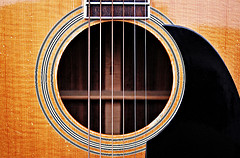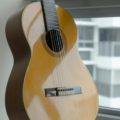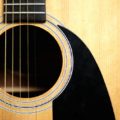Guitar chords are formed when a combination of at least three or more notes are played simultaneously. They create harmonious sounds by pressing down specific notes on all strings together or on a combination of individual strings.
In popular music, the most commonly known instruments have six strings. Each string is tuned from the lowest pitch to the highest pitch, designated with the letters E-A-D-G-B-E. The thinnest string has the highest pitch and is called the first string, while the thickest string has the lowest pitch and is designated as the sixth string.
Some players use a finger slide to transition between pitches easily. The intervals between most strings are tuned to perfect fourths, except for the interval between the second B string and the third G string, which forms a major third.
In heavy metal and hard rock music, the tuning is slightly different. Known as Drop D tuning, the low E string is tuned to a D. This creates power tuning, where the bottom three strings become a root fifth octave, D-A-D.
The five primary chord shapes are A Major, C Major, D Major, E Major, and G Major. These major triads serve as fundamental reference points and are played in open positions.
B Major and F Major are the two remaining major chords that require the first finger to hold multiple strings on the fingerboard.
In addition to major chords, there are minor, augmented, and diminished chords. Minor chords are similar to major chords, except they have a minor third instead of a major third. Augmented chords are built with a major third and an augmented fifth, while diminished chords consist of a minor third and a diminished fifth.
An inverted chord is created when the bass note is not the root note. Most contemporary music does not include inverted chords with six-string harmonies because the root pitch is covered by the bass.
A sequential progression of root pitches is called a harmonic progression. This succession creates a continuous shift of tonality, which has been a central element of European music since 1600. The shifting of tonality usually occurs on accented beats.
A variety of musical styles are created using guitar chords. They are formed by pressing down a specific combination of strings on certain frets. While they can be challenging for new players to master, they are an essential component of music.
Manuel Marino is a seasoned Senior Producer, Music Composer, and Artist with over a decade of experience. He specializes in branded entertainment across various mediums, including video games, films, and advertising campaigns. With 20+ years as a game music composer, Manuel has worked on numerous platforms, creating diverse orchestral soundtracks. HIRE ME


 Manuel is a passionate, driven, and techsavvy AV technician,
Manuel is a passionate, driven, and techsavvy AV technician, 










